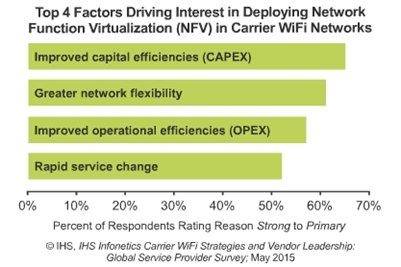 Carrier WiFi Strategies and Vendor Leadership: Global Service Provider Surveyによると、2016年までにアクセスポイントの26%がホットスポット2.0準拠となり、WiFiネットワーク間、WiFiと携帯ネットワーク間でシームレスなローミングが可能になると回答企業の4分の1が予想しているという。
Carrier WiFi Strategies and Vendor Leadership: Global Service Provider Surveyによると、2016年までにアクセスポイントの26%がホットスポット2.0準拠となり、WiFiネットワーク間、WiFiと携帯ネットワーク間でシームレスなローミングが可能になると回答企業の4分の1が予想しているという。「キャリアWiFiの展開を促している主要因は収入の増加です。ホットスポット2.0はWiFiとモバイル・携帯ネットワークとの統合だけでなく、WiFiサービスにとっての新たな収益モデルの構築もサポートしているのです」と、IHSでモバイルバックホールとスモールセルを担当しているリサーチディレクターのRichard Webb氏は述べている。
「当社がインタビュー調査をした全てのキャリアは、自社のキャリアWiFi ネットワークでネットワーク機能バーチャライゼーション(NFV)を展開する明確な計画を現時点で策定しているわけではありませんが、このような動きの背景には収入が関係しています。そのほか、資本支出(capex)や営業経費(opex)の効率性、ネットワーク柔軟性の向上、高速サービスへの変更のサポートも上位にあげられています」と、Webb氏は続けて述べている。 キャリアWIFI調査のハイライト
- 調査対象企業によると、キャリアWiFi展開を促進する要因で上位にあげられたものはチャーン回避、モバイルブロードバンドとのバンドルサービス、カバレッジの向上、WiFiアクセスでの新たな収入となっている。
- 調査対象となったキャリアは様々なマネタイゼーションのモデルを採用している。複数層のホットスポットとWiFiローミングは2016年にかけて最も成長する。
- Ruckus WirelessとCiscoは、3年連続でキャリアWiFiベンダーのトップ企業として調査対象企業から認識されている。
Hotspot 2.0 and Virtualization Key to New Revenue for WiFi Carriers London, UK (May 26, 2015)- IHS (NYSE: IHS) conducted in-depth surveys with service providers across the globe that operate carrier WiFi networks or will do so soon and found that respondents expect to significantly increase their access point deployments by the end of 2016. The 2015 IHS Infonetics Carrier WiFi Strategies and Vendor Leadership: Global Service Provider Survey also shows that a quarter of the respondents expect that by 2016, 26 percent of their access points will be Hotspot 2.0-compliant to enable seamless roaming among WiFi networks and between WiFi and cellular networks.
"Revenue generation has become a key driver of carrier WiFi deployments. Not only does Hotspot 2.0 support integration of WiFi with mobile and fixed networks, but it supports the creation of new revenue models for WiFi services," said Richard Webb, research director for mobile backhaul and small cells at IHS.
"While not all of the carriers we interviewed currently have firm plans to deploy network functions virtualization (NFV) in their carrier WiFi networks, the drivers for doing so relate to revenue, with capex and opex efficiency, greater network flexibility and support for rapid service changes topping the list," added Webb. CARRIER WIFI SURVEY HIGHLIGHTS
- Survey respondents' top drivers for deploying carrier WiFi are preventing churn, bundling service with mobile broadband, improving coverage and generating new WiFi access revenue
- Carriers surveyed are adopting a growing variety of monetization models, with tiered hotspots and WiFi roaming growing the fastest through 2016
- For the third straight year, Ruckus Wireless and Cisco lead respondent perception of top carrier WiFi vendors

